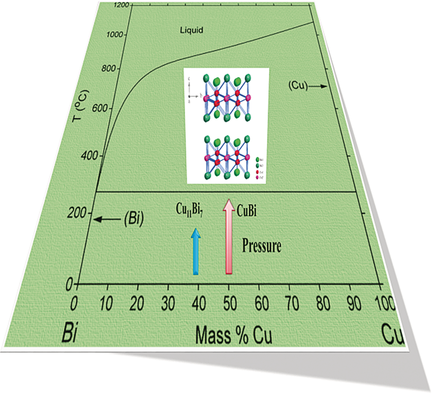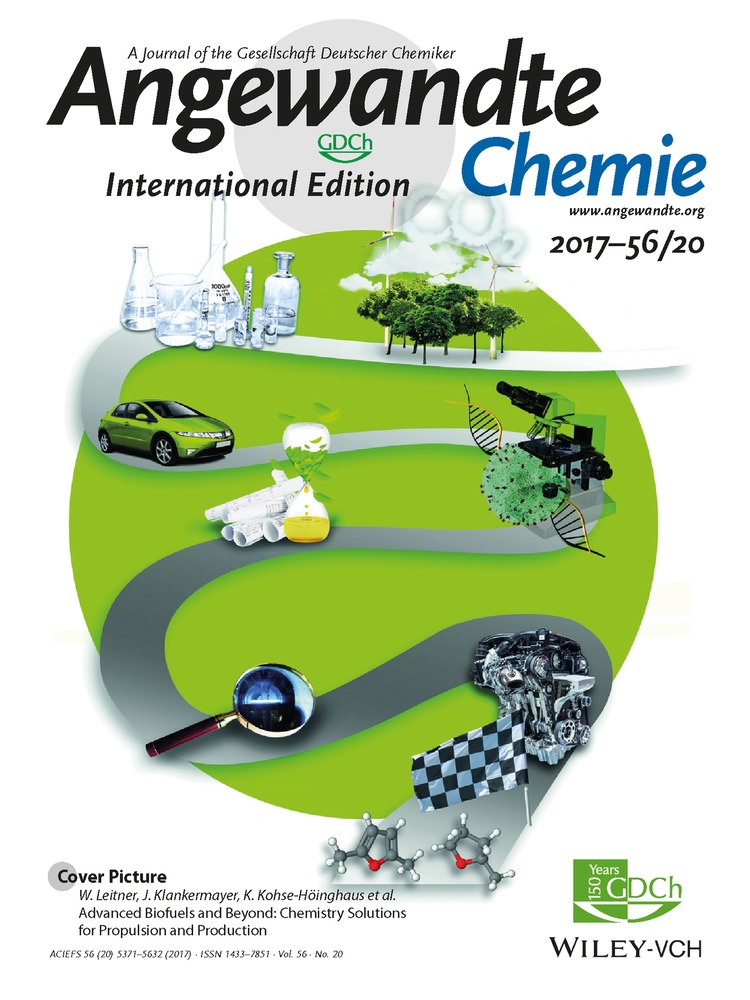Weak Interactions under Pressure: hp-CuBi and Its Analogues
Dr. Kai Guo
School of Materials Science and Engineering, Shanghai University, China
Chemische Metallkunde, Max-Planck-Institut für Chemische Physik fester Stoffe, 01187 Dresden, Germany
Search for more papers by this authorDr. Lev Akselrud
Chemische Metallkunde, Max-Planck-Institut für Chemische Physik fester Stoffe, 01187 Dresden, Germany
Search for more papers by this authorDr. Matej Bobnar
Chemische Metallkunde, Max-Planck-Institut für Chemische Physik fester Stoffe, 01187 Dresden, Germany
Search for more papers by this authorDr. Ulrich Burkhardt
Chemische Metallkunde, Max-Planck-Institut für Chemische Physik fester Stoffe, 01187 Dresden, Germany
Search for more papers by this authorDr. Marcus Schmidt
Chemische Metallkunde, Max-Planck-Institut für Chemische Physik fester Stoffe, 01187 Dresden, Germany
Search for more papers by this authorProf. Dr. Jing-Tai Zhao
School of Materials Science and Engineering, Shanghai University, China
State Key Laboratory of Advanced Special Steel, Shanghai University, China
Search for more papers by this authorCorresponding Author
Priv.-Doz. Dr. Ulrich Schwarz
Chemische Metallkunde, Max-Planck-Institut für Chemische Physik fester Stoffe, 01187 Dresden, Germany
Search for more papers by this authorProf. Yuri Grin
Chemische Metallkunde, Max-Planck-Institut für Chemische Physik fester Stoffe, 01187 Dresden, Germany
Search for more papers by this authorDr. Kai Guo
School of Materials Science and Engineering, Shanghai University, China
Chemische Metallkunde, Max-Planck-Institut für Chemische Physik fester Stoffe, 01187 Dresden, Germany
Search for more papers by this authorDr. Lev Akselrud
Chemische Metallkunde, Max-Planck-Institut für Chemische Physik fester Stoffe, 01187 Dresden, Germany
Search for more papers by this authorDr. Matej Bobnar
Chemische Metallkunde, Max-Planck-Institut für Chemische Physik fester Stoffe, 01187 Dresden, Germany
Search for more papers by this authorDr. Ulrich Burkhardt
Chemische Metallkunde, Max-Planck-Institut für Chemische Physik fester Stoffe, 01187 Dresden, Germany
Search for more papers by this authorDr. Marcus Schmidt
Chemische Metallkunde, Max-Planck-Institut für Chemische Physik fester Stoffe, 01187 Dresden, Germany
Search for more papers by this authorProf. Dr. Jing-Tai Zhao
School of Materials Science and Engineering, Shanghai University, China
State Key Laboratory of Advanced Special Steel, Shanghai University, China
Search for more papers by this authorCorresponding Author
Priv.-Doz. Dr. Ulrich Schwarz
Chemische Metallkunde, Max-Planck-Institut für Chemische Physik fester Stoffe, 01187 Dresden, Germany
Search for more papers by this authorProf. Yuri Grin
Chemische Metallkunde, Max-Planck-Institut für Chemische Physik fester Stoffe, 01187 Dresden, Germany
Search for more papers by this authorGraphical Abstract
The metastable binary compound hp-CuBi was prepared from copper and bismuth at 5 GPa and 720 K. The atomic arrangement consists of slabs of puckered Cu layers sandwiched between Bi planes. Analysis of the chemical bonding reveals multicenter interactions within and van der Waals type interactions between the slabs. The new compound is a superconductor below Tc=1.3 K.
Abstract
The metastable binary compound hp-CuBi was obtained from the direct chemical reaction between copper and bismuth at a pressure of 5 GPa and a temperature of 720 K. The atomic arrangement comprises slabs of puckered Cu layers sandwiched between Bi planes. The QTAIM charges calculated for compounds of bismuth with transition metals reveal negligible charge transfer for hp-CuBi. Analysis of the chemical bonding with position-space techniques discloses multicenter interactions within the Bi-Cu-Bi slabs and lone-pair interactions of the van der Waals type between these entities. hp-CuBi exhibits metal-type electrical conductivity with superconductivity below Tc=1.3 K.
Supporting Information
As a service to our authors and readers, this journal provides supporting information supplied by the authors. Such materials are peer reviewed and may be re-organized for online delivery, but are not copy-edited or typeset. Technical support issues arising from supporting information (other than missing files) should be addressed to the authors.
| Filename | Description |
|---|---|
| anie201700712-sup-0001-misc_information.pdf166.7 KB | Supplementary |
Please note: The publisher is not responsible for the content or functionality of any supporting information supplied by the authors. Any queries (other than missing content) should be directed to the corresponding author for the article.
References
- 1Q. Zhu, D. Y. Jung, A. R. Oganov, C. W. Glass, C. Gatti, A. O. Lyakhov, Nat. Chem. 2013, 5, 61–65.
- 2J. V. Badding, Annu. Rev. Mater. Sci. 1998, 28, 631–656.
- 3P. F. McMillan, Chem. Soc. Rev. 2006, 35, 855–857.
- 4W. Zhang, A. R. Oganov, A. F. Goncharov, Q. Zhu, S. E. Boulfelfel, A. O. Lyakhov, E. Stavrou, M. Somayazulu, V. B. Prakapenka, Z. Konôpková, Science 2013, 342, 1502–1505.
- 5R. Demchyna, S. Leoni, H. Rosner, U. Schwarz, Z. Kristallogr. 2006, 221, 420–434.
- 6P. F. McMillan, Nat. Mater. 2002, 1, 19–25.
- 7P. F. McMillan, High-Pressure Res. 2003, 23, 7–22.
- 8U. Schwarz, S. Tencé, O. Janson, C. Koz, C. Krellner, U. Burkhardt, H. Rosner, F. Steglich, Yu. Grin, Angew. Chem. Int. Ed. 2013, 52, 9853–9857; Angew. Chem. 2013, 125, 10038–10042.
- 9S. M. Clarke, J. P. S. Walsh, M. Amsler, C. D. Malliakas, T. Yu, S. Goedecker, Y. Wang, C. Wolverton, D. E. Freedman, Angew. Chem. Int. Ed. 2016, 55, 13446–13449; Angew. Chem. 2016, 128, 13644–13647.
- 10P. Pykkö, Chem. Rev. 1988, 88, 563–594.
- 11D. J. Chakrabarti, D. E. Laughlin, Bull. Alloy Phase Diagrams 1984, 5, 148–155.
- 12O. Teppo, J. Niemelä, P. Taskinen, Thermochim. Acta 1990, 173, 137–150.
- 13A. K. Covington, K. Groenwolt, B. W. Howlett, J. Inst. Met. 1960–1961, 89, 291–292.
- 14J. P. S. Walsh, S. M. Clarke, Y. Meng, S. D. Jacobsen, D. E. Freedman, ACS Cent. Sci. 2016, 2, 867–871.
- 15Y. P. Yarmolyuk, P. I. Kripyakevich, Dopov. Akad. Nauk Ukrain RSR 1976, A1, 86–88. For comparing the structure motif with CuBi, please note the different selection of the asymmetric unit and the shift in origin.
- 16M. Nuding, M. Ellner, J. Alloys Compd. 1997, 252, 184–191.
- 17A. V. Tkachuk, Y. A. Mozharivskyj, A. Mar, Z. Kristallogr. 2006, 221, 539–542.
- 18J.-F. Bérar, P. Lelann, J. Appl. Crystallogr. 1991, 24, 1–5.
- 19A. Simon, Angew. Chem. Int. Ed. Engl. 1997, 36, 1788–1806; Angew. Chem. 1997, 109, 1873–1891.
- 20R. F. W. Bader, Atoms in Molecules, A Quantum Theory, Clarendon Press and Oxford University Press Inc, New York, 1994.
- 21V. P. Glagoleva, G. S. Zhdanov, Sov. Phys. JETP 1956, 3, 155–158.
- 22Q. F. Gu, G. Krauss, Yu. Grin, W. Steurer, J. Solid State Chem. 2007, 180, 940–948.
- 23R. Boldt, J. Wosnitza, A. Grigas, M. Heise, T. Herrmannsdörfer, A. Isaeva, S. Kaskel, D. Köhler, M. Ruck, R. Skrotzki, Z. Anorg. Allg. Chem. 2012, 638, 2035–2043.
- 24A. Isaeva, M. Ruck, K. Schäfer, U. C. Rodewald, R. Pöttgen, Inorg. Chem. 2015, 54, 885–889.
- 25M. Kohout, Int. J. Quantum Chem. 2004, 97, 651–658.
- 26F. R. Wagner, V. Bezugly, M. Kohout, Yu. Grin, Chem. Eur. J. 2007, 13, 5724–5741.
- 27M. Kohout, Faraday Discuss. 2007, 135, 43–54.
- 28M. Ruck, Reference Module in Chemistry, Molecular Sciences and Chemical Engineering, Elsevier, Amsterdam, 2015.
- 29M. Ruck, F. Locherer, Coord. Chem. Rev. 2015, 285, 1–10.
- 30Yu. Grin, U. Wedig, H. G. von Schnering, Angew. Chem. Int. Ed. Engl. 1995, 34, 1204–1206; Angew. Chem. 1995, 107, 1318–1320.
- 31O. Prakash, A. Kumar, A. Thamizhavel, S. Ramakrishnan, Science 2016, DOI: 10.1126/science.aaf8227.
- 32N. N. Zhuravlev, G. S. Zhdanov, Sov. Phys. JETP 1955, 1, 91–102.
- 33F. Weitzer, W. Schnelle, R. Cardoso Gil, S. Hoffmann, R. Giedigkeit, Yu. Grin, CALPHAD Comput. Coupling Phase Diagrams Thermochem 2009, 33, 27–30.





